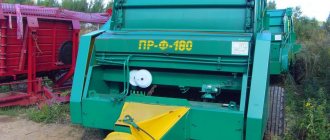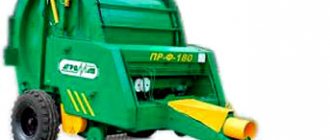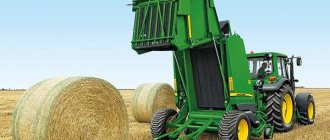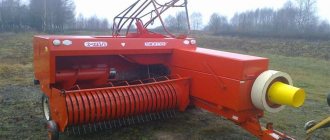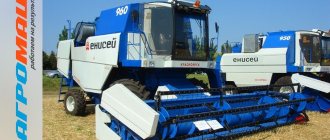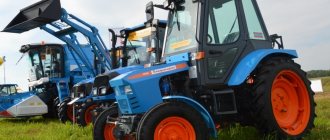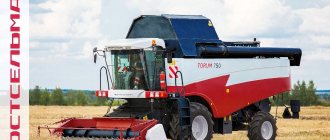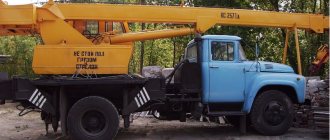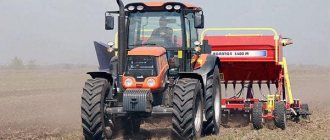After harvesting the wheat or mowing the grass, the remaining mass must be removed, but this must also be done efficiently with minimal losses. Roll balers, which are designed to pick up straw or grass and roll it into a roll, are ideal for this. The PRF 180 unit has a fairly simple and reliable design, which is capable of ensuring a minimum amount of losses.
Closed chamber round baler PRF-180
The PRF-180 roll baler with a permanent pressing chamber is designed for collecting and pressing natural and seeded grass and straw into rolls of hay, followed by wrapping the roll with twine.
The twine is fed using an electric drive.
The PRF-180 version of the baler is equipped with an automated control system (ACS), which allows you to monitor the operation of the baler mechanisms and remotely control the technological process.
Due to the use of a closed bale chamber, this type of baler has low feed losses. Increased density on the surface of the roll and looseness in the middle provides better air permeability.
Specifications
Description of equipment features:
- This is a beltless round baler.
- The technique has a short cycle of forming a roll of the finished product.
- The user can adjust the density of the final product.
- The equipment can be connected to both a tractor and a walk-behind tractor.
- The winding design includes a drive, a shaft, a gearbox and a tank for winding twine.
- The main mechanisms are the camera and the wheel shaft.
- The device consumes a small amount of fuel liquid, about 3-4 liters per hour.
- Spare parts from the entire model range are interchangeable.
- A high level of productivity is ensured by the pressure grid and pressing mechanism.
Maintenance and repair
Main malfunctions and methods for their elimination in accordance with the operating instructions for the unit:
- If the pin from the flywheel is often cut off, it is recommended to disassemble the mechanism and sharpen the knives or replace them.
- If the clutch pawl jams, it is necessary to run in the knitting machine for 15-20 minutes.
- When the clutch does not operate, it means that an external inspection of the mechanism should be carried out for damage and defects. If necessary, replace the coupling.
- If the winding twine breaks, it is necessary to inspect the spring tensioner, adjust the gap between the mechanisms, and slightly loosen the tension of the brake twine spring device.
- When the hook does not grab the twine, it is recommended to check the position and serviceability of the clamps. If necessary, replace or adjust the mechanism.
- If the device does not start, you need to check the fuel fluid level and inspect the power unit for defects.
Baler PR-F-180: technical characteristics
Leader of its class in the “Price/Quality” category
Those who lived in the days of hand-harvesting feed remember what a long and difficult work it was. Mow hay, dry it in windrows, collect them in stacks, then load them, take them to a storage place, where they unload and diligently engage in stacking... And so many times over the summer. Nowadays, this hard physical work has become much easier thanks to the introduction of special agricultural machines. Along with mowers, round balers have become valuable assistants in the production of feed. "PRF-180" is one of the best models of such machines on the modern market. Balers of this type have been produced by Agromash (Bobruisk) and Unisibmash (Novosibirsk) since the late 90s of the 20th century.
About enterprises -
Bobruisk has been working since 1974. In Soviet times, it produced fertilizer spreaders with a lifting capacity of 8 to 18 tons. (More than 26 thousand such agricultural machines per year). In the 90s, it became obvious that the only way for an enterprise to survive in new economic conditions was to reorient production towards new, competitive types of products and significantly expand the range of products.
Since that time, he began to produce a wide range of goods that were in demand on the market in all republics of the former Soviet Union: trailers and semi-trailers for cars and tractors, including tippers; scales; grain grinders (crushers); equipment for harvesting and post-harvest processing/sorting of potatoes; garage doors of all types; fences and fences, stoves and barbecues, etc.
It was also decided to start production of machines for mechanizing forage harvesting work. Moreover, the issue of mechanization of labor in the procurement and distribution of feed was approached in a comprehensive manner. Balers of the “PRF” type are produced in various modifications, so that they can be used in both large and small peasant farms, and even in subsidiary farming.
.
In parallel with the balers, the plant's design bureau developed and subsequently put into production TR-F-5 roll transporters; unwinder-distributor of roughage - RGK-1; four-rotor disc mower KDN-210, rake-tedder GVR-630 and feed dispenser KRF-10. Thus, Bobruiskagromash produces agricultural machines for each stage of feed procurement and feed distribution.
Since 1995, Novosibirsk has been producing NASH brand sunflower and corn harvesters, and since the early 2000s, also cultivators, drum mowers and roll balers of several types. Including a model similar to the Bobruisk “PRF-180” - “PR-180M”. Let's consider the main technical characteristics, features of the design and operation of this agricultural machinery.
About the history of the model and manufacturing companies
Until April 2008, the production of the PR-200 baler was carried out at the Ryazan Combine Harvester Plant (in modern times - an open joint-stock company). This enterprise for the production of agricultural machinery has existed since 1905. During the years of the USSR it was called the “Order of the Badge of Honor” and specialized in the production of trailed equipment for pre-sowing tillage; for harvesting hay, sugar beets and potatoes.
In the place of the destroyed one, according to the tradition of our era, the construction of a new residential complex immediately began.
In 2007, the company was declared insolvent (bankrupt), and in 2010 it was excluded from the unified state register. Currently, an analogue of balers of this brand is its copy under the name “PR-120M”, produced in Novosibirsk. This enterprise, in addition to roll balers of several models, also produces headers for harvesting sunflower and corn, wheel-finger and mounted rakes, drive chains for a wide range of agricultural and industrial equipment.
Purpose of "PRF-180" on the farm and its main features
The main purpose of the beltless round baler "PRF-180" with a permanent bale chamber is to mechanize and automate the process of harvesting hay and straw, reducing manual labor to a minimum. This is a tractor semi-trailer with one axle and a cylindrical bale chamber. The chamber is of a completely closed design, helping to reduce the amount of feed loss to a minimum. The baler collects windrows of hay or straw cleanly and efficiently, no less efficiently than with a rake and fork. And it rolls them into rolls weighing up to 700 kilograms of hay and up to 400 kg of straw, securing these rolls with twine.
The result of the work of "PRF-180" in mowing.
Design Features
"PR-200" is one of the compact round balers of a beltless design (with a chain drive). Unlike belt presses, the PR-200 press forms a more uniform density over the entire area of the formed roll. Moreover, regardless of the density and uniformity of the selected roll of hay or straw, across its entire width. Small overall dimensions allow the PR-200 baler to be used on any fields, including small-contour formats.
Baler "PR-120M" at work.
The bale wrapping apparatus is equipped with both a mechanical and an electric drive and is started from a remote control from the tractor cabin. (But in the “PR-200” of the early years of production there is only a mechanical “blinker”). The wheels of the picking mechanism provide for smooth height adjustment for harvesting hay and straw, and a limited ability to copy the terrain on flat fields. To work on difficult terrain (with bumps, holes), bumpers (“skis”) are provided.
The device of the baler "PRF-180"
The baler can be divided into the following components (units and assemblies):
- Lobovina. The front component of an agricultural machine in which the drive for connecting the trailer to the tractor is located. Namely, PTO - power take-off shaft, safety clutch, shaft with half-couplings, bevel gearbox; drive shaft of the pressing mechanism and rollers. The lobovina is intended for aggregating the trailer with a tractor and ensuring the operation of the picking and pressing mechanisms. Also on the front part there are drawers for tools and skeins of twine, as well as a tying device. Before opening the pressing chamber, the clutch of the pressing mechanism is automatically disconnected by means of a rope pull.
Adjustments
According to the instructions, for proper operation of the baler without failures and malfunctions, it is necessary to make adjustments, which include:
- Setting the drive safety clutch to a torque of 400+20 Nm.
- Setting the pick-up safety clutch to a torque of 3000 Nm.
- Adjusting the claw clutch of the pressing mechanism drive. The distance between the teeth of the open chamber coupling halves is 5-6 mm, and the closed one - 12-14 mm.
- Correct installation of the pick-up sign. The movement of the mechanism must be free of jamming and jamming.
- Chain tension. It is considered sufficient when manually pulling from the line of movement by 6-15 mm.
- Setting the alarm for the required density.
- Adjustment of the roll winding pitch.
- Setting the distance between the stop and the knife of the wrapping machine. Its range is 4-6 mm.
- Adjusting the tension of the pressing mechanism.
- Adjustment of the location of the rear camera closing latches. The distance of the latches with the chamber closed is 0-2 mm.
- Adjustment of wheel hub bearings.
Operating principle of the PRF-180 pick-up
In the process of forward movement across the field, the spring teeth of the pick-up mechanism rake the entire swath and feed the forage mass into the bale chamber. The lower rollers and rolling pins spin the roll into a mass, and due to the upper pressure grid, it is pressed and compacted. When the specified level of bale density is reached, a sound signal is given to the operator. If the roll is fixed with twine, the machine operator needs to manually feed the twine into the chamber, after which the roll is wrapped and the rope is cut mechanically. The finished roll is unloaded using the lower rollers after opening the press chamber.
In the open position of the camera, the selection mechanism is supported by springs and rests with wheels on the ground, and in the raised position it is secured with latches. To bring it into working position, the tractor power take-off shaft is first connected. The latches open only when the pick-up drive shaft begins to rotate.
Baler "PR-200" at work
The principle of operation of the beltless round baler “PR-200” is as follows. As the towbar moves over the windrow of dried grass, the fingers of the baler are activated, grabbing the hay from the ground and directing it into the bale chamber.
In this cylindrical compartment, with the help of rollers and a pressing mechanism, the entire mass of incoming grass is constantly given a rotational movement. At the same time, the supply of new portions of hay continues continuously. During the rotation process, the feed mass is compacted quite quickly, crumpling into a homogeneous hard roll.
Baler "PR-120M" with tractor "T-25 Vladimirets".
As the grass arrives, the density of the mass in the roll steadily increases. Until finally the maximum possible bale density is reached. About this, a signal is sent to a special device through the upper roller. New feeds of hay into the bale chamber are stopped by the upper roller of the press to prevent clogging of the receiving hole. Noticing the alarm, the operator turns on the winding machine, which is powered by an electric drive. The baler stops and the bale is secured with twine. At the end of wrapping, the operator opens the back panel of the bale chamber, and the lower rotating rollers carefully roll out the roll to the ground. After this unloading and closing the rear panel of the chamber, the process of pressing a new roll is repeated.
Reviews from PRF-180 owners about operating experience
In general, peasants agree that round balers are more convenient, more technologically advanced and more practical than square balers. And productivity is higher, and it takes much less time to clean and store rolls than bales (one bale weighs about 15-20 kg). Farmers note: even if the weather turns bad and rain clouds appear, you can quickly remove and roll up windrows of hay or straw from a large area with a roller pick-up and save them from dampness. This trick won't work with bales.
A haystack loads finished rolls of hay.
Among the disadvantages of the PRF-180 pick-up, it is necessary to make the windrows uniform and uniform for clean, high-quality harvesting. Therefore, sometimes preliminary preparation and alignment of the windrows is required. Not everyone likes the size and weight of the rolls (too large). Almost all owners of the “PRF-180” talk about the low quality of the metal from which it is made, nostalgically recalling the high-grade metal that agricultural machinery was made of during the Soviet era. However, the quality and integrity of the assembly of the Bobruisk plant does not raise any complaints.
Reviews from owners of PR-200 balers
Peasants who have gained experience working with PR-200 balers most often note that the experience was generally positive. This equipment is unpretentious, undemanding, and copes with its direct responsibilities with dignity, works properly and with minimal breakdowns for 10 seasons or more. The design is simple, which means it is reliable and, as practice shows, durable. Chains, unlike belts, almost never break, and there are no unplanned stops in work.
The result of the work of the PR-200 baler.
Indeed, a chain baler has proven to be more convenient to use than a belt baler. In particular, the hay does not need to be dried as thoroughly as with belt balers, which produce a denser and heavier bale. I rolled the mown feed material into a bundle, sniffed it - if it no longer smells like grass, but like hay, you can safely remove it, even if it’s raining a little. The rolls are formed of sufficient density to be breathable, and the hay will not rot during storage.
Disadvantages and problems of the PR-200 baler. Firstly, the low quality of the metal from which it is made and its coloring. After only 2-3 seasons of operation, the rust reaches such proportions that the equipment looks as if it is already “a hundred years old.” Those wishing to buy “PR-200” from the late 90s/early 2000s “on the cheap” should take into account that the old-style presses had a weaker pressing mechanism. The rollers on the rolling pin regularly fall off at the place where they are connected to the chain. When you work with such a press, you need to have a familiar turner who will also regularly turn out the holders and bushings for you (which are lost without a trace along with the bearing).
Some solved this problem simply and radically: completely removing both the upper and lower mechanism from the press and welding everything tightly in place with the fingers that pass through the chain. But in newer models of these presses, this problem has already been completely solved by the manufacturer; the rolling pins are much more reinforced.
The second weak point of the PR-200, which almost all its owners talk about, is the upper roller. “We all know about this, and we can’t fight it, you just need to have it in stock, it can be changed within half an hour, the most important thing is not to break the spherical bearings, a rather scarce thing.”
The third problem manifests itself when working on loose soil, “mochezhina” (where groundwater is always close to the surface, or the area is slightly swampy). “PR-200” gets stuck in such areas, gets up and presses “reluctantly”. The problem is solved by installing wheels of a larger diameter or width (for example, from Niva).
Some customize the baler to suit their individual needs and the characteristics of their farm. For example, changes are made to the wrapping mechanism in order to save twine or increase the speed of wrapping rolls.
New and used PRF-180 balers on the market
This baler model is supported by the fact that Bobruiskagromash supplies it not only to Russia and other republics of the former Soviet Union, but also to more than 20 countries around the world (including most former socialist countries, Finland, Sweden and Denmark; countries of Central and South America). "PRF-180" demonstrates a very good combination of price and quality.
There are dealers of the Bobruisk plant in all agricultural regions of Russia and the CIS, so there are no problems with purchasing PRF-180 balers and spare parts for them. The new “PRF-180” costs 400-480 thousand rubles (plus/minus several tens of thousands, depending on the region). The price for used balers of this model, produced in 2000, varies from 220 to 320 thousand rubles.
Technical characteristics and dimensions of the round baler (PR-200)
We organize delivery of round balers (PR-200)
to the place at the minimum cost by a transport company or passing transport to any region of Russia and neighboring countries
Tomsk region (Tomsk), Republic of Mari El (Yoshkar-Ola), Republic of Adygea (Maikop), Kostroma region (Kostroma), Irkutsk region (Irkutsk), Ust-Ordynsky Buryat Autonomous Okrug (urban settlement Ust-Ordynsky), Republic of Komi (Syktyvkar ), Ulyanovsk region (Ulyanovsk), Oryol region (Orel), Nizhny Novgorod region (Nizhny Novgorod), Chukotka Autonomous Okrug (Anadyr), Saratov region (Saratov), Tambov region (Tambov), Novosibirsk region (Novosibirsk), Tula region (Tula ), Moscow region (Moscow), Republic of Karachay-Cherkessia (Cherkessk), Republic of Mordovia (Saransk), Bryansk region (Bryansk), Sakhalin region (Yuzhno-Sakhalinsk), Kamchatka region (Petropavlovsk-Kamchatsky), Tyumen region (Tyumen), Evenki Autonomous Okrug (Tura town), Penza region (Penza), Republic of North Ossetia-Alania (Vladikavkaz), Kaliningrad region (Kaliningrad), Vladimir region (Vladimir), Vologda region (Vologda), Rostov region (Rostov-on-Don) , St. Petersburg (St. Petersburg), Chita region (Chita), Smolensk region (Smolensk), Republic of Bashkortostan (Ufa), Altai Republic (Gorno-Altaisk), Chuvash Republic (Cheboksary), Samara region (Samara), Stavropol Territory (Stavropol), Republic of Sakha (Yakutia) (Yakutsk), Orenburg Region (Orenburg), Belgorod Region (Belgorod), Leningrad Region (St. Petersburg), Astrakhan Region (Astrakhan), Jewish Autonomous Region (Birobidzhan), Nenets Autonomous district (Naryan-Mar), Kabardino-Balkarian Republic (Nalchik), Kirov region (Kirov), Khanty-Mansiysk Autonomous Okrug (Khanty-Mansiysk), Republic of Kalmykia (Elista), Amur region (Blagoveshchensk), Kursk region (Kursk), Kemerovo Region (Kemerovo), Koryak Autonomous Okrug (urban settlement Palana), Taimyr (Dolgano-Nenets) Autonomous Okrug (Dudinka), Udmurt Republic (Izhevsk), Ryazan Region (Ryazan), Kurgan Region (Kurgan), Republic of Buryatia (Ulan-Ude) ), Ivanovo Region (Ivanovo), Chechen Republic (Grozny), Komi-Permyak Autonomous Okrug (Kudymkar), Republic of Tatarstan (Kazan), Krasnodar Territory (Krasnodar), Lipetsk Region (Lipetsk), Yamalo-Nenets Autonomous Okrug (Salekhard), Magadan region (Magadan), Republic of Tyva (Kyzyl), Altai region (Barnaul), Chelyabinsk region (Chelyabinsk), Murmansk region (Murmansk), Pskov region (Pskov), Omsk region (Omsk), Sverdlovsk region (Ekaterinburg), Yaroslavl region (Yaroslavl), Voronezh region (Voronezh), Aginsky Buryat highway. district (Aginskoye town), Perm region (Perm), Arkhangelsk region (Arkhangelsk), Krasnoyarsk region (Krasnoyarsk), Novgorod region (Novgorod), Republic of Dagestan (Makhachkala), Primorsky region (Vladivostok), Volgograd region (Volgograd), Moscow (Moscow), Khabarovsk Territory (Khabarovsk), Republic of Khakassia (Abakan), Republic of Karelia (Petrozavodsk), Republic of Ingushetia (Nazran), Tver Region (Tver), Kaluga Region (Kaluga), as well as to other regions and populated areas points.
Didn't find what you were looking for? Or do you need advice on selecting equipment to solve your problems?
Write to us what interests you in the field below. And, our managers will contact you as soon as possible!
